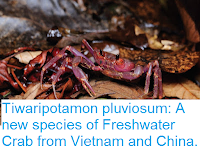Coconut Crabs, Birgus latro, are the largest terrestrial Crustacean species, and indeed largest terrestrial Arthropod of any description. It is found across much of the Indian and Pacific Oceans, living on most landmasses where Coconuts are found (though in some areas they have been exterminated to protect commercial Coconut crops). They are descended from Hermit Crabs, and younger Coconut Crabs still use borrowed Snail shells for protection, but the adult Crabs have developed tough calcareous exoskeletons. Like other Decapod Crustaceans, Coconut Crabs have large chelae (claws) which are their main method of food manipulation and defence. Studies of other Decapods have been shown to be capable of exerting a considerably greater pinching force with their claws than the bite of similarly sized Vertebrates, making the pinching force of the Coconut Crab potentially very formidable.
In a paper published in the journal PLoS One on 23 November 2016, Shin-ichiro Oka, Taketeru Tomita and Kei Miyamoto of the Okinawa Churashima Foundation, describe the results of an experiment designed to test the strength of the claws of the Coconut Crab.
Oka et al. collected 29 Coconut Crabs from Ocean Expo Park on Northern Okinawa Island, ranging in size from 16.2 mm in length and 33 g in weight to 64.5 mm in length and 2120 g in weight and measured their pinching force with a device used to measure crushing force when an animal bites down on a stainless steel stick-shaped sensor, and in addition took measurements of their claws.
Measurement of the pinching force and claw morphology in the Coconut Crabs. (a) The force was measured with the SK-MBF-01F device (SkyScience Co. Tokyo, Japan) and related sensors and (b) demonstration of the method by which pinching force was measured. (c) Claw measurements of the Coconut Crab used in this study. The placement of the sensor used for pressure measurement is highlighted in green. The measurements used for claw length (CL), claw height (CH), and claw width (CW) are also indicated. L1: in-lever length from the fulcrum to the apodemes insertion; LBAE: out-lever length from the fulcrum to the tubercle (the contact point with the device sensor). Oka et al. (2016).
Oka et al. found that the pinching force of the claws related directly to the size of the Crabs, with the smallest Crab exerting a pinch of 29.4 Newtons, and the largest 1765.2 Newtons. However even the largest Crabs used in the study were considerably smaller than the maximum size for the species, about 4 kg. Assuming that the strength of larger Crabs continues to scale up in the same way, Oka et al. calculate that they could exert a pinch-force of 3300 Newtons, greater than the pinch-force measured from any other Crustacean, and higher than the bite-force recorded from any terrestrial predator except Alligators.
See also...
Follow Sciency Thoughts on
Facebook.







